
| Contents | Prev | Next | JDBCTM Guide: Getting Started |
java.sql package. This document contains the specification
for the core JDBC 2.1 API. The second component, termed the JDBC 2.0 Optional
Package API, comprises the contents of a new package, javax.sql, which as its name
implies will be delivered as an optional package to the Java platform (formerly Java
Standard Extension). The JDBC 2.0 Optional Package API is described in a separate
document.
The java.sql package contains all of the additions that have been made to the existing
interfaces and classes, in addition to a few new classes and interfaces. The new javax.sql
package has been introduced to contain the parts of the JDBC API which are
closely related to other pieces of the Java platform that are themselves Optional Packages
, such as the Java Naming and Directory Interface (JNDI), and the Java Transaction
Service (JTS). In addition, some advanced features that are easily separable from the
core JDBC API, such as connection pooling and rowsets, have also been added to javax.sql
. Putting these advanced facilities into an optional package instead of into core
will help keep the core JDBC API small and focused.
Since optional packages are downloadable, it will always be possible to deploy an application which uses the features in the JDBC Optional Package that will "run anywhere ," since if an optional package isn't installed on a client machine, it can be downloaded along with the application that uses it.
The separate core JDBC 2.1 API documentation contains the Java programming language
definitions of the java.sql interfaces and classes listed above. The figure below
shows the more important core interfaces and their relationships. The important relationships
between interfaces have not changed with the introduction of the new JDBC
API.
The list below contains the classes and interfaces that comprise the javax.sql package.
A detailed specification of these new types is contained in a separate document.
javax.sql.ConnectionEventListener
javax.sql.ConnectionPoolDataSurce